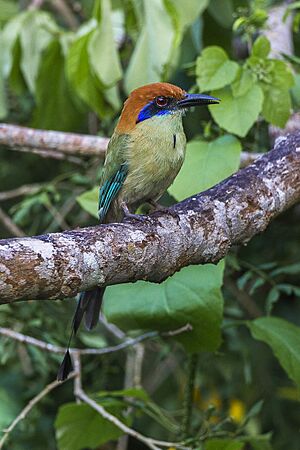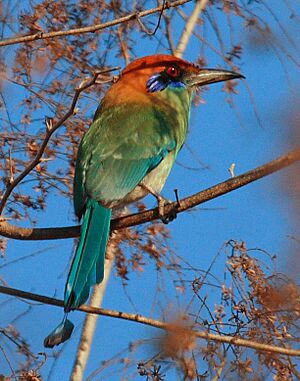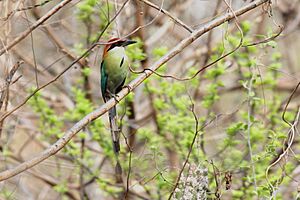Russet-crowned motmot facts for kids
Quick facts for kids Russet-crowned motmot |
|
|---|---|
 |
|
| Conservation status | |
| Scientific classification | |
| Genus: |
Momotus
|
| Species: |
mexicanus
|
 |
|
| Range | |
The russet-crowned motmot (Momotus mexicanus) is a beautiful bird found in north-western Mexico and central Guatemala. It lives all year round in warm, dry forests and scrublands.
The word "russet" means reddish-brown. It describes the color of this bird's head. The word comes from the Latin word russus, which means red.
Contents
What is a Motmot?
Motmots are a type of bird that belongs to a larger group called Coraciiformes. This group also includes other cool birds like bee-eaters, rollers, and kingfishers. The russet-crowned motmot is one of seven species in the Momotus group, which is part of the Momotidae family.
These birds really like to stay in one place. They often return to the same nesting areas year after year. This is because it's hard to find good places to build their nests. Because they don't move around much, different groups of these birds can become quite unique. Scientists have found that even groups living fairly close to each other can be very different genetically.
There are four types, or subspecies, of russet-crowned motmots:
- M.m. mexicanus
- M.m. vanrossemi
- M.m. saturates
- M.m. castaneiceps
The M.m. castaneiceps subspecies lives in a very isolated area in central Guatemala. Some scientists think it might even be a separate species!
Appearance and Features
How Big Are They?
Russet-crowned motmots are medium-sized birds. They are about 30.5 to 35.5 centimeters (12 to 14 inches) long. They weigh between 74 and 104 grams (about 2.6 to 3.7 ounces).
Both male and female motmots look very similar in color. However, females have slightly shorter tail feathers. A female's tail is usually 10 to 15 cm long, while a male's can be 11 to 22 cm.
Colors and Markings
These birds have a reddish-brown crown (the top of their head) and nape (the back of their neck). Their back and wings are green. Their main wing feathers are a pretty blue-green color.
Their chest is light green with a black spot. Their belly is even lighter. They have a long blue tail with a unique bare section near the tip. This creates a dark, racket-shaped tip on their longest central feathers.
Their black beak is slightly jagged and curves downwards. Like most motmots, they have a black mask around their eyes. This mask is outlined with blue and violet feathers. They have reddish eyes and grey legs and feet. Young motmots have brown eyes and duller colors.
The four subspecies have slightly different looks:
- M.m. vanrossemi is paler than M.m. mexicanus.
- M.m. saturates is larger and darker.
- M.m. castaneiceps has a darker reddish-brown crown. Its black eye-mask is also larger.
What Do They Sound Like?
The russet-crowned motmot makes a low "krrp" or "krrup" sound. They often string these sounds together to make a longer call. They can also make a hollow "ook" sound. Mated pairs sometimes sing together, taking turns calling back and forth.
Where They Live
Russet-crowned motmots prefer older forests with lots of tree cover. But you can also find them in younger forests that have good canopy coverage. They live in both dry and humid tropical forests and open areas. They can be found at altitudes up to 1800 meters (about 5,900 feet).
These birds live along the western coast of Mexico. There is also a separate group in central Guatemala. They are quite common in these areas.
- The M.m. vanrossemi subspecies lives in north-western Mexico. You can see them in Sonora, Sinaloa, and Chihuahua.
- M.m. mexicanus is found from Sinaloa down to Oaxaca along the west coast.
- M.m. saturates lives in south-western Mexico and Guatemala.
- M.m. castaneiceps used to be found only in the Motagua Valley of central Guatemala. But in 2018, it was also seen in the Nentón valley. This suggests their living area might be getting bigger.
Behavior and Life
What Do They Eat?
Russet-crowned motmots eat large invertebrates like grasshoppers. They also enjoy fruits and small vertebrates such as snakes and lizards.
They have a special way of catching food called "flycatching." They sit on a low branch and then quickly dart out to grab an insect or a piece of fruit. After catching their meal, they fly back to their perch. If the prey is still alive, they hit it against the branch before swallowing it.
Reproduction and Family Life
Russet-crowned motmots are socially monogamous. This means that a male and female bird pair up during the breeding season. They both work together to care for their young. They share all the tasks equally.
The breeding season is from May to July, which is the wet season. These birds usually breed once a year. They lay a small clutch of 4 to 5 eggs. This is common for birds in tropical areas. The eggs hatch after about 15 to 20 days. Both parents feed the hatchlings. The young birds, called fledglings, leave the nest after 30 to 42 days.
About 68% of their eggs hatch successfully. And 56% of the young birds successfully fledge (leave the nest). Most deaths happen during the egg incubation period. Snakes and iguanas are the main predators that eat their eggs or young.
Nesting Habits
Russet-crowned motmots dig tunnels in the ground to make their nests. They usually choose earthen banks, roadsides, or river banks. Each pair digs a tunnel that is about 88 to 170 centimeters (about 3 to 5.5 feet) deep. The tunnels are mostly flat and can curve. They have a special chamber at the end for the eggs.
These tunnels are only for breeding. But the areas where they build their nests are also used for finding food and resting. Finding good nesting spots is hard because the tunnels need the right kind of soil. If the soil isn't good, the tunnels can flood or collapse. Loam soil, which is a mix of sand, silt, and clay, is best. It drains well, is easy to dig, and allows for good air flow.
Since good nesting spots are rare, these birds tend to stay in the same areas. They return to their old nesting grounds because they already know if the spot is safe, has food, and is good for raising chicks.
How Long Do They Live?
Scientists believe that a russet-crowned motmot can live for at least 11 years. This idea comes from one bird that was caught and then found again 10 years later.
Protecting Their Space
Territory is very important to russet-crowned motmots because good nesting areas are scarce. So, they are very protective of their space. However, one observer saw them with other bird species like woodpeckers and orioles. This suggests that they mainly defend their territory against other motmots, not other types of birds.
When another motmot enters their territory, a russet-crowned motmot might hold a leaf in its beak. This is a way of showing that they are ready to fight before they chase or fight the intruder. This behavior happens all year, even when they are not breeding. Both male and female motmots defend their territory.
Mated pairs react differently to male and female intruders. They are more aggressive towards male intruders. If a male intruder holds a leaf, the paired motmots will get closer to chase or fight him. But if a female intruder holds a leaf, the paired motmots will also hold a leaf to warn her.
Conservation Status
Even though the IUCN (International Union for Conservation of Nature) says russet-crowned motmots are of "least concern" for conservation, their homes are still in danger. The number of good nesting sites is decreasing. This is due to changes in climate and human activities.
More rain from climate change can cause nests to flood or collapse. Also, farming in places like the Motagua Valley in Guatemala reduces the available nesting grounds for the M.m. castaneiceps subspecies. When forests are broken up into smaller pieces, it also makes the birds more likely to be affected by parasites or predators.
The russet-crowned motmot could become endangered if their habitats are not protected.




